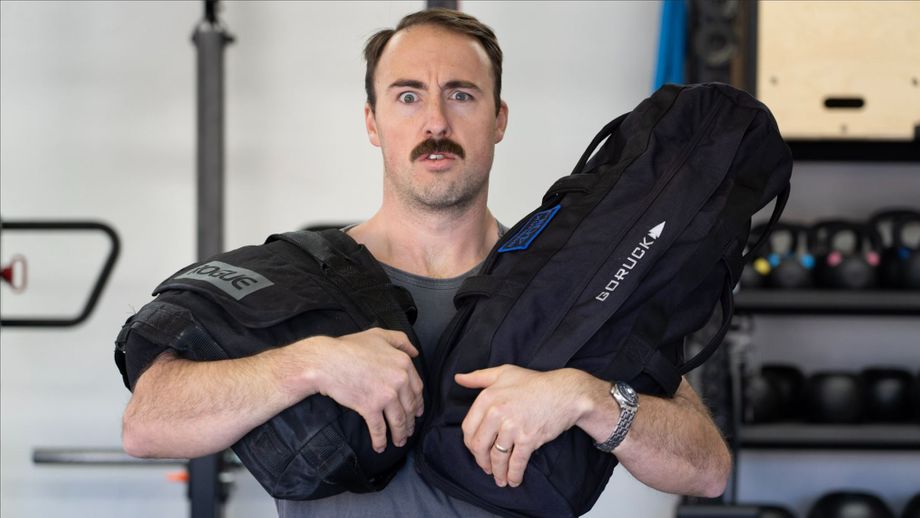We test and review fitness products based on an independent, multi-point methodology. If you use our links to purchase something, we may earn a commission. Read our disclosures.
If I had to survive with just one piece of fitness equipment, it would be a sandbag.
If I had access to all the fitness equipment in the world, but could only choose one exercise, it would be a sandbag-over-shoulder. Before my home gym had a power rack, barbell, strongman log, or chains, it had a half dozen sandbags.
To build strength and functional fitness, I just don’t think anything beats a big bag of sand. And that’s why I’m excited to share with you the best sandbag workouts to hit every muscle group.
Benefits of Sandbag Workouts
Sandbags, like all odd objects, tax your stabilizer muscles and grip strength harder than gasoline in California (it’s ok, I grew up there so I’m allowed to say it). While barbells and dumbbells are literally designed to be lifted (how weird is it that something exists with the sole purpose of possessing mass?), sandbags aren’t intrinsically engineered to exist in your center of gravity.
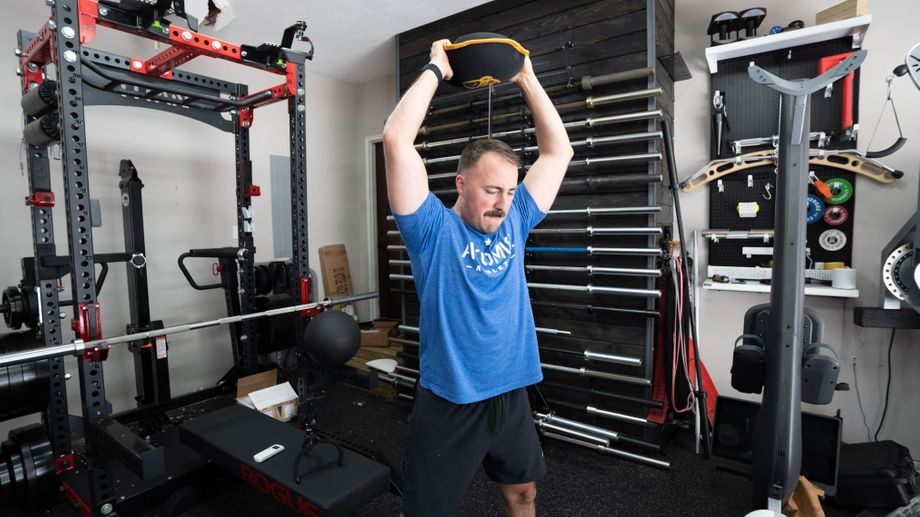
Versatility for the Whole Body
Sandbags offer you an array of incredibly versatile workouts for both your upper body and lower body. Movements with sandbags can be more efficient at burning fat by being less efficient movements (a true paradox in fitness). You’re going to have to activate and stress all kinds of stabilizer muscles to keep the sandbag from throwing YOU around.
You can buy sandbags with handles, but those aren’t my preference. By adding handles to a sandbag, you turn a functional strength training tool into a mushy kettlebell. Finding ways of holding onto the bag without handles is what forces you to grip harder with not only your hands, but your core and upper back. No other training tool in the gym can mimic this “bear-hug” type of maneuvering, whereas plenty of pieces of equipment in gyms allow you to grip a handle.
Affordable and Compact
The sandbag is a tool we can use to build total-body strength, but it’s not a piece of equipment that lends itself to a standard strength periodization model. You won’t typically have access to hundreds of sandbags, each 5 pounds heavier than the previous.
This makes it great for “extra” home workouts. It’s an affordable piece of equipment (I just made my own with heavy duty trash bags as filler bags) and it doesn’t take up a lot of space, so you don’t even need an entire home gym to house it.
Build Strength
I also think sandbags should be heavy (heavy of course is a relative word based on your strength and fitness level). I don’t think you get a whole lot out of a workout routine where you move weight you can stock shelves with (otherwise you would be applying to work at Costco rather than joining a gym).
If you aren’t brand new to weight training or HIIT workouts, starting these types of routines with a sandbag around half your bodyweight should feel somewhere between “possible” and “kinda light.”
Triple Extension, Simplified
Anyone with Olympic weightlifting experience knows the importance of triple extension in power development1. Triple extension refers to three joints (hips, knees, and ankles) all being locked out. It’s complicated to explain but simply to demonstrate; try to touch the rim on a basketball hoop. When you jump you have to triple extend to get off the ground.
Weightlifters load this position hard with the snatch and clean, but these are highly technical lifts. Keeping your back straight at the extreme ranges of motion needed to “catch” a snatch at the bottom can take years of work.
I find picking up a sandbag and sitting with it 100X easier than with a snatch. For the life of me, I can’t catch a barbell any lower than a 1/8th squat, but I can sit my butt on my Achilles with a heavy sandbag without my lower back splitting in two.
With a heavy duty sandbag, you can effectively load this extension2 without years spent in a Russian weightlifting school. While weightlifters usually live in the lower rep range, I love doing high rep sandbag throws and loads!
Sandbag Exercises
So, what can you do with a sandbag? The answer is, “A lot.”
(If you choose to use a sandbag with handles, just replace the “back of hands on the ground” cue with “grab the handles” in the instructions below).
Sandbag Lunges
Muscles Targeted: Quads, glutes, hamstrings, core
How to Do It:
- Start with your feet hip-width apart. You can bear hug the sandbag, or throw it over one of your shoulders.
- Step forward with the right leg and bend at the left knee. Get a good stretch at the bottom, but don’t let your back knee drop onto the ground.
- Keep the tension on your muscle, and keep your front knee behind your toe (unless you are going over for a VERY specific reason).
- Step the right foot back to meet the left. Try to really explode through that front foot.
- Repeat on the left side.
Trainer Tip: I do these with the sandbag on one shoulder at a time and walk the lunges rather than do them in place. The unbalanced load really works your core strength, and you get to count this as your weighted carry for the day. You can also do reverse lunges (stepping back instead of forward).
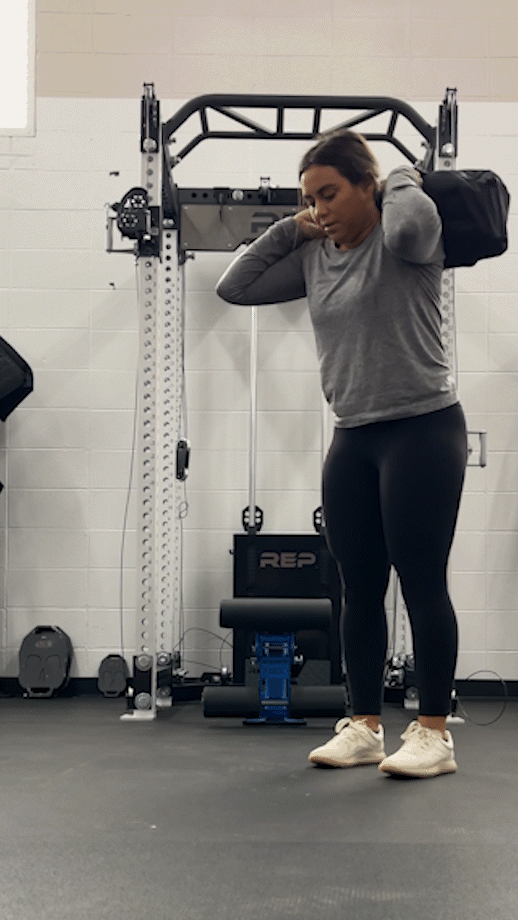
Sandbag Bent-Over Rows
Muscles Targeted: Upper back (lats, traps, rhomboids), forearms, grip, biceps
How to Do It:
- The starting position is with the bag in front of you with your feet roughly shoulder width apart. If you have an oblong bag, place it so it is longest from left foot to right foot.
- Get your hips into the same position as with your deadlift (somewhere between a quarter squat and a half squat).
- Grab the bag on either end. You can scoop the bag if you’re having a hard time thinking about gripping it. Put the back of your right hand on the ground and shimmy it under that side of the sandbag, then repeat with your left hand. Squeeze your hands, arms, and back as hard as you can.
- Bring the bag to your chest. Repeat.
Trainer Tip: If you’re an experienced lifter, use as much body-english as you want. If we wanted to isolate these muscles, we’d use a machine. Every motion with a sandbag is a full body heave, as long as you aren’t subjecting yourself to injury.
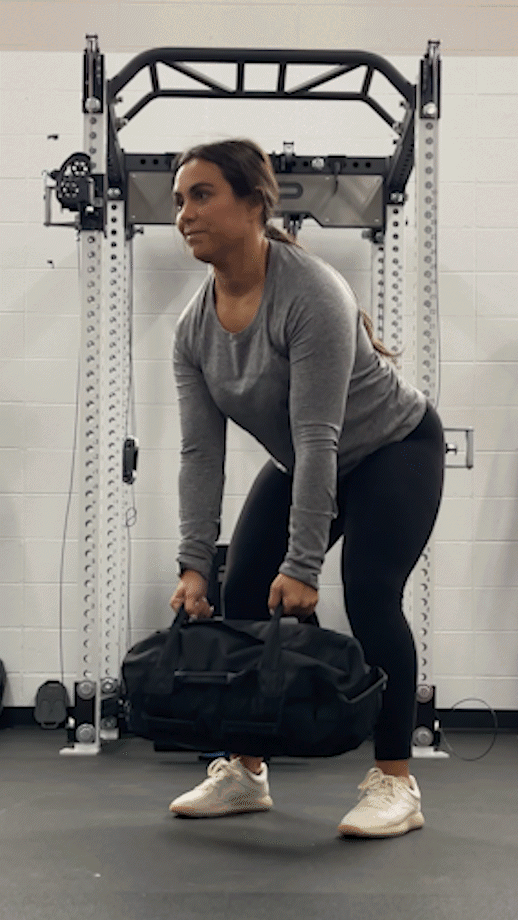
Sandbag Deadlift
Muscles Targeted: Glutes, hamstrings, upper back
How to Do It:
- Feet can be hip-width apart or a little wider to accommodate the diameter of your sandbag, with the sandbag directly in front of your feet.
- Get your hips lower than you would in a conventional deadlift, and shimmy your hands under the bag like with the row. The grip coming up will be very hard (it’s why strongman competitors use tacky when loading Atlas Stone).
- Squeeze your arms and pinch the bag in them.
- Stand up explosively, keeping a flat back and tight core.
Trainer Tip: You can widen your feet and place the sandbag between them if reaching in front of you for the bag is too difficult or awkward.
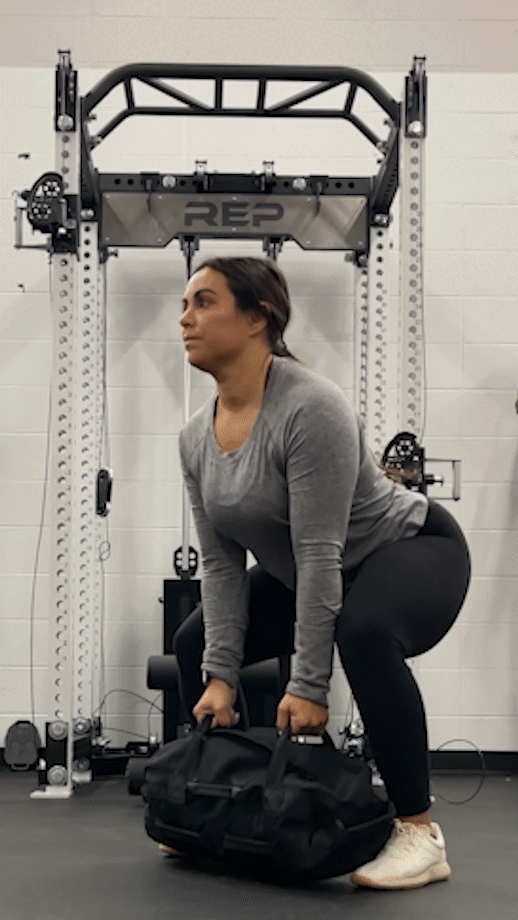
Sandbag Presses
Muscles Targeted: Shoulders, triceps, traps, core
How to Do It:
- Start from the top position of the Sandbag Deadlift.
- Pop your hips and throw the sandbag into a front rack position (just like a front squat).
- Get your hands as flat as possible under the sandbag.
- Get super stable and perform an overhead press by pushing the bag overhead, finishing with your biceps near your ears.
Trainer Tip: The front rack and top lockout position are both much less stable than in a barbell overhead press. Focus on taking a deep breath, keeping your abs and obliques tight, and engage your traps by thinking about shrugging when you get the bag over your head.
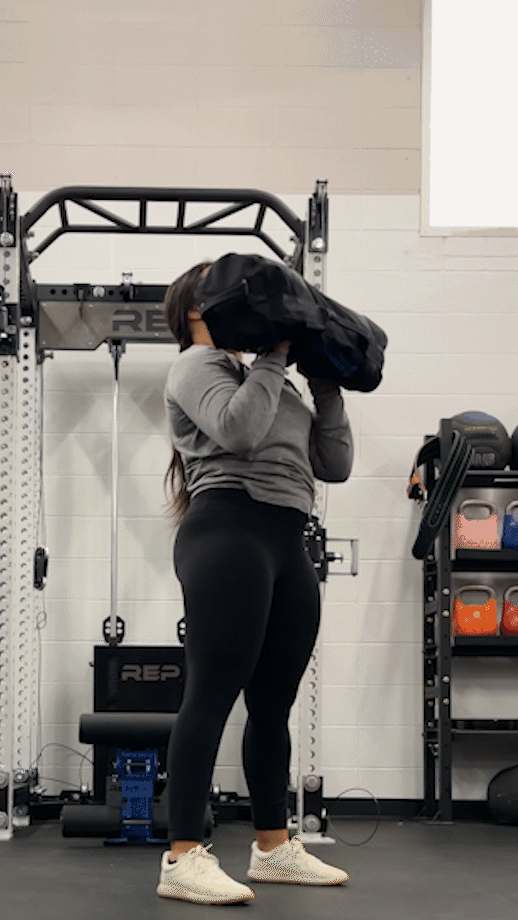
Sandbag-to-Shoulder
Muscles Targeted: Glutes, hamstrings, traps, core
How to Do It:
- Start with your feet hip-width apart with the sandbag in front of you, like you do with the sandbag deadlift.
- Bend over and grab the sandbag in the middle.
- In one movement, lift the bag, forcibly extending the hips and using that momentum to pull the sandbag to one of your shoulder.
Some beginners get this triple-extension/jump/Olympic lifting feel quickly and some don’t. You’re trying to JUMP the sandbag to your shoulder, not delicately place it there.
Trainer Tip: When the bag has a bigger diameter and is heavier, you may need to get more creative. After deadlifting it, drop under it in a quarter squat, then sit with it between your legs. Try to reach your arms over the top of it and form your body to the contours of the sandbag. This puts more of your body’s surface area on the sandbag and lets you exert more control over it (kinda like a mountain climber hugging the cliff-face). You can then extend your hips and use your arms to pull the bag up to your shoulder.
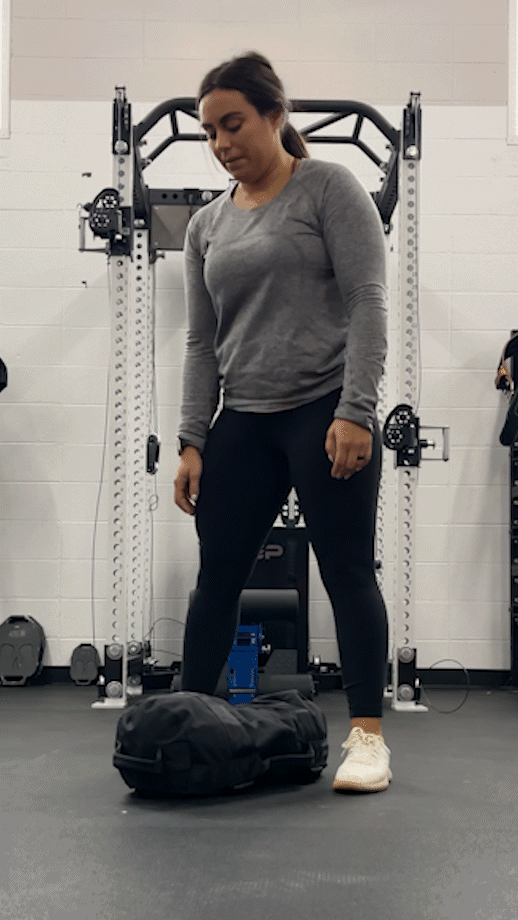
Sandbag Get-Up
Muscles Targeted: Quads, obliques, upper back
How to Do It:
- Lie on the ground and get your sandbag on top of you.
- Now get up with it.
There aren’t fancy steps and balancing acts like in a Turkish get-up. Getting back down without plopping can be even harder, but make sure you squeeze your abs tight and do it. Falling down with a heavy weight isn’t typically a good idea.
Trainer Tip: The sandbag is going to press on your lungs, especially heavier weight bags. You’ve just got to grit through it.
Full Body Sandbag Workouts
This first workout is a gut-check. It’s great for anyone training for a firefighter academy because you get to work on life-saving skills like getting up off the ground and breathing when you really don’t want to breathe.
Anyone can replace a lower-body day with this, or do it on an off-day. This is especially fun to do in multiple teams of two. It gives you a little rest and gives you some juice to go hard.
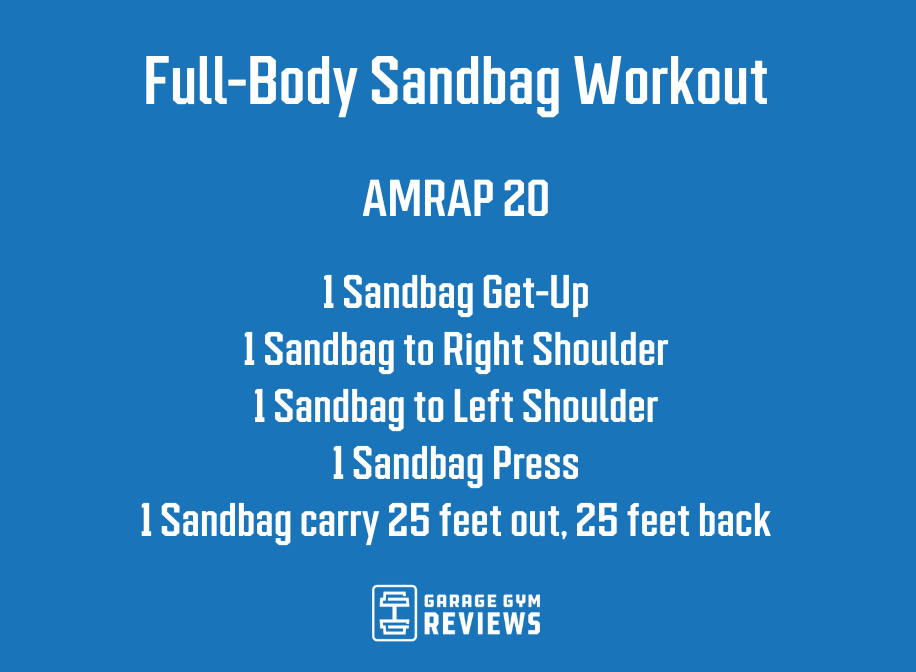
AMRAP 20
- 1 Sandbag Get-Up
- 1 Sandbag to Right Shoulder
- 1 Sandbag to Left Shoulder
- 1 Sandbag Press
- 1 Sandbag carry 25 feet out, 25 feet back
*Do as many rounds as possible in 20 minutes.
You don’t technically need a lot of space for this second sandbag workout, but it helps mentally.
Sandbag Carry Workout
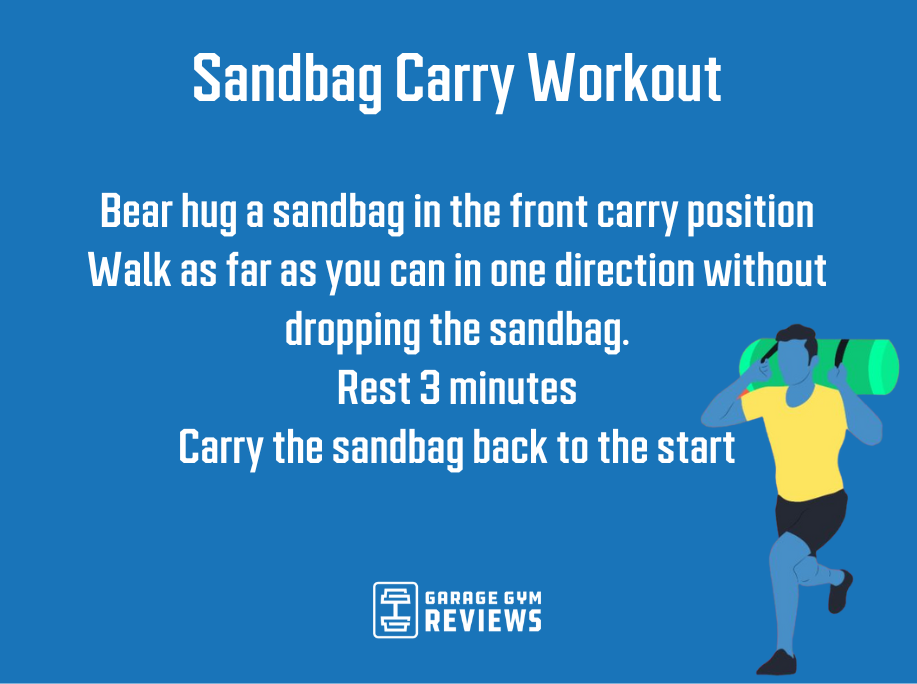
- Bear hug a sandbag in the front carry position
- Walk as far as you can in one direction without dropping the sandbag. You can pause and reposition, but you can’t drop it.
- When you drop it rest for 3 minutes
- Carry the sandbag back to where you started
I wouldn’t do this more than like once a month. It’s not something you should train for or try to periodize. Coming back home will take you 2-3 times as long as going out, and when you finish you’ll know why I suggest you not plan to do it very often.
Best Sandbag Workouts: Q&A
How effective are sandbag workouts?
Brutally effective. Moving around a sandbag that weighs as much as your bodyweight is about as taxing as it gets. The strength and cardio needed to carry what is essentially yourself around cannot be minimized.
Can you build muscle with a sandbag?
Heck yeah! Back when I was a member of Global Strongman Gym, we had people come in all the time who thought they were way past being able to make “newbie gainz.” They were proficient, strong, and most importantly, adapted to barbell lifting, but the new stimulus of sandbags and atlas stones rocked their world (not to mention their upper back and glutes).
How often should you do sandbag workouts?
You need to treat sandbag training like weight training3; moderation. If you want to regularly use sandbags as a 10-minute finisher after a barbell workout go ahead, but don’t drop a 2 hour sandbag workout after an intense squat day.
Are sandbags better than weights?
Sandbags are weights! They just don’t fit onto a barbell.
Sandbag training is the epitome of functional training. Professionals such as those involved in firefighting, law enforcement, military, sanitation, and any other job where you spend time picking up awkward, dead weight can use sandbags to help immure their bodies to the grind of their work.
It’s hard to target a single muscle group with a sandbag, which makes it both better and worse than free weights and machines. For total body strength and conditioning, it’s hard to beat a sandbag.
References
1. Chang E, Norcross MF, Johnson ST, Kitagawa T, Hoffman M. Relationships between explosive and maximal triple extensor muscle performance and vertical jump height. J Strength Cond Res. 2015 Feb;29(2):545-51. doi: 10.1519/JSC.0000000000000652. PMID: 25187243.
2. Calatayud J, Colado JC, Martin F, Casaña J, Jakobsen MD, Andersen LL. CORE MUSCLE ACTIVITY DURING THE CLEAN AND JERK LIFT WITH BARBELL VERSUS SANDBAGS AND WATER BAGS. Int J Sports Phys Ther. 2015 Nov;10(6):803-10. PMID: 26618060; PMCID: PMC4637915.
3. Judge LW, Burke JR. The effect of recovery time on strength performance following a high-intensity bench press workout in males and females. Int J Sports Physiol Perform. 2010 Jun;5(2):184-96. doi: 10.1123/ijspp.5.2.184. PMID: 20625191.
Further reading

These bumpers are IWF-certified for the competition stage, but are they worth the space in your home gym? Find out in our Rogue Competition Bumpers review. Read more

We’ve compiled the best 4th of July treadmill sales so you can be up and running toward your fitness goals without breaking your budget. Read more

Plant-based athletes can excel in the weight room with our top picks for the best vegan creatine supplements. Read more

Spinning your wheels trying to find the best Black Friday exercise bike deals? Time to employ the kickstand, as GGR has you covered with the top sales you won’t want to miss. Read more

